Air Canada’s new Aeroplan program has launched as of today, November 9, 2020. In this post, we’ll go over all of the new details we’ve learned today, now that we’ve had some time to play around with the new Aeroplan search engine and all of its features.
If you still need to get caught up on all the information we know about the new-and-transformed Aeroplan, then refer to this series of posts for everything you need to know, as well as this post for the new Aeroplan co-branded credit card bonuses that were recently announced.
Without further ado, let’s walk through the new Aeroplan platform that was launched today, as well as everything new we learned today about about the new Aeroplan program.
In This Post
- Member Dashboard
- The New Search Engine
- Air Canada Dynamic Pricing
- Preferred Pricing
- Different Fare Categories
- Points + Cash
- Priority Rewards
- Complex Bookings
- Aeroplan Call Centre
- Conclusion
Member Dashboard
Aeroplan is now an integrated part of the Air Canada website. You’ll log in with the same credentials as you did before, which will bring you to the Aeroplan member dashboard.
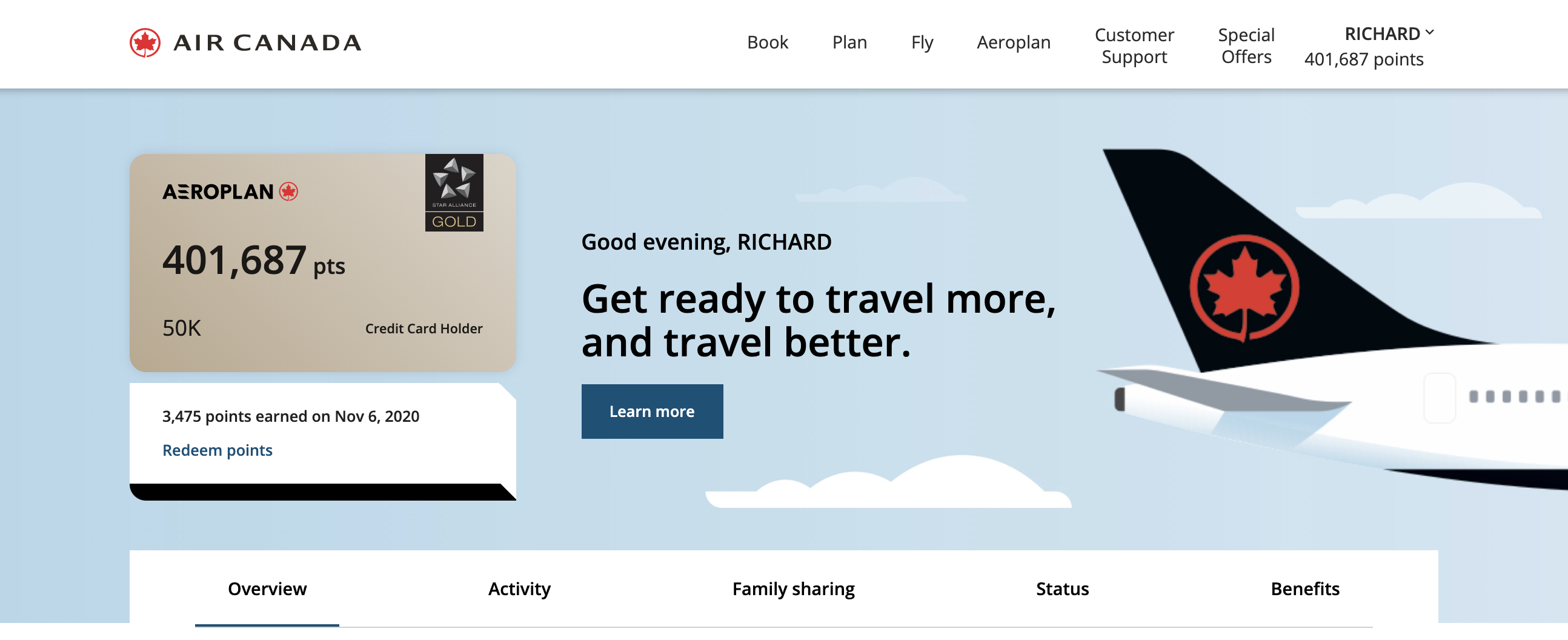
Here, you can get an at-a-glance view of your member information, Aeroplan Elite Status, credit card ownership, and any benefits you have in your account currently (such as eUpgrades and Priority Rewards).
Under the Family Sharing tab, you’re able to get started setting up your family pool. For each member you invite, you’ll need to input their first and last name, Aeroplan number, the familial relationship, and whether or not that family member has the ability to redeem points out of the family pool.
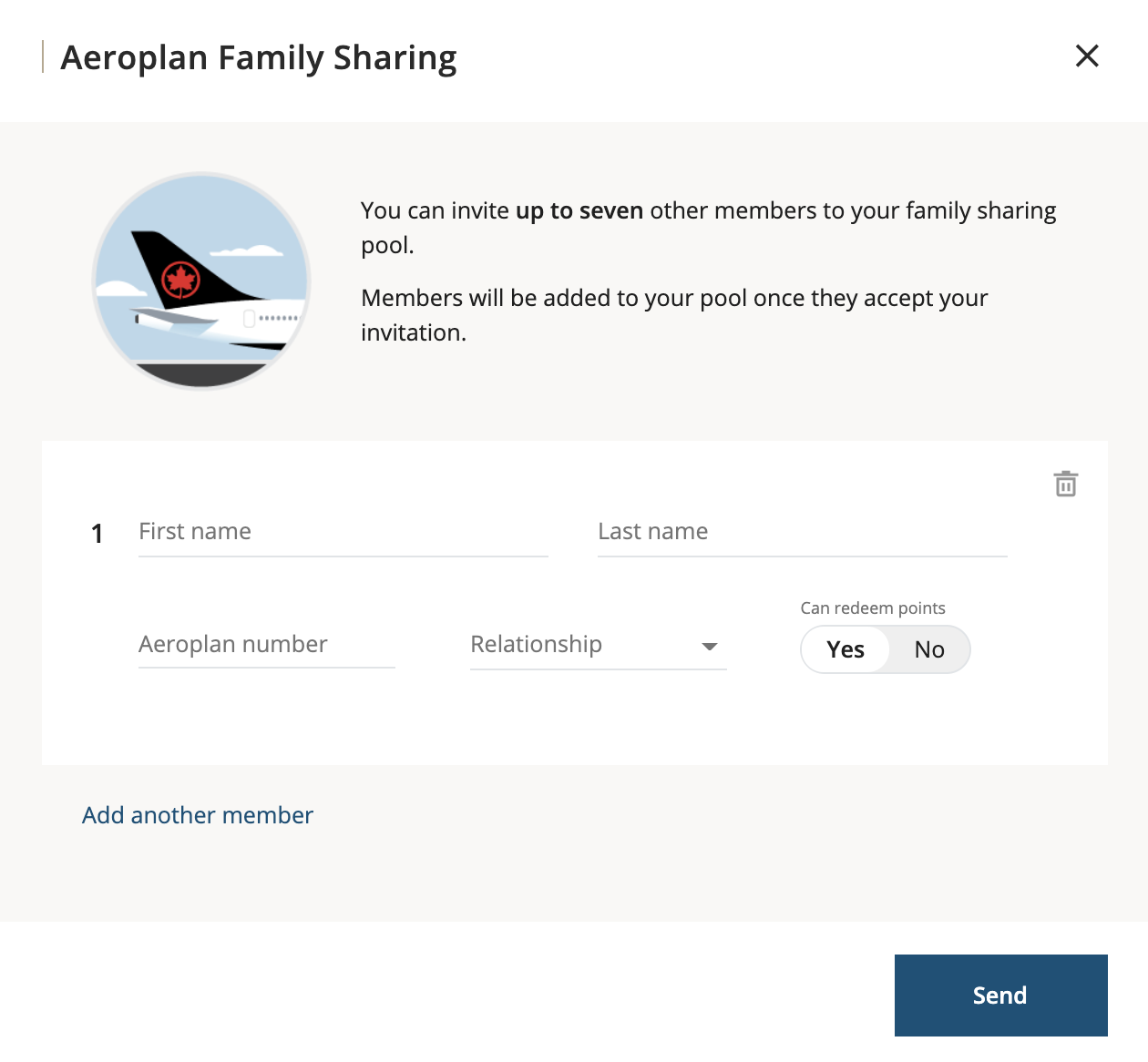
The Status tab replaces the previous Air Canada Altitude dashboard, showing how close you are to the next status level, your Threshold eUpgrades and Threshold gifts, and your Status Qualifying Dollars (SQD) progress towards earning Priority Rewards.
(Don’t forget, if you’re an Aeroplan 35K member or above, you’ll have already received some Priority Rewards in your account as a one-time welcome gesture.)
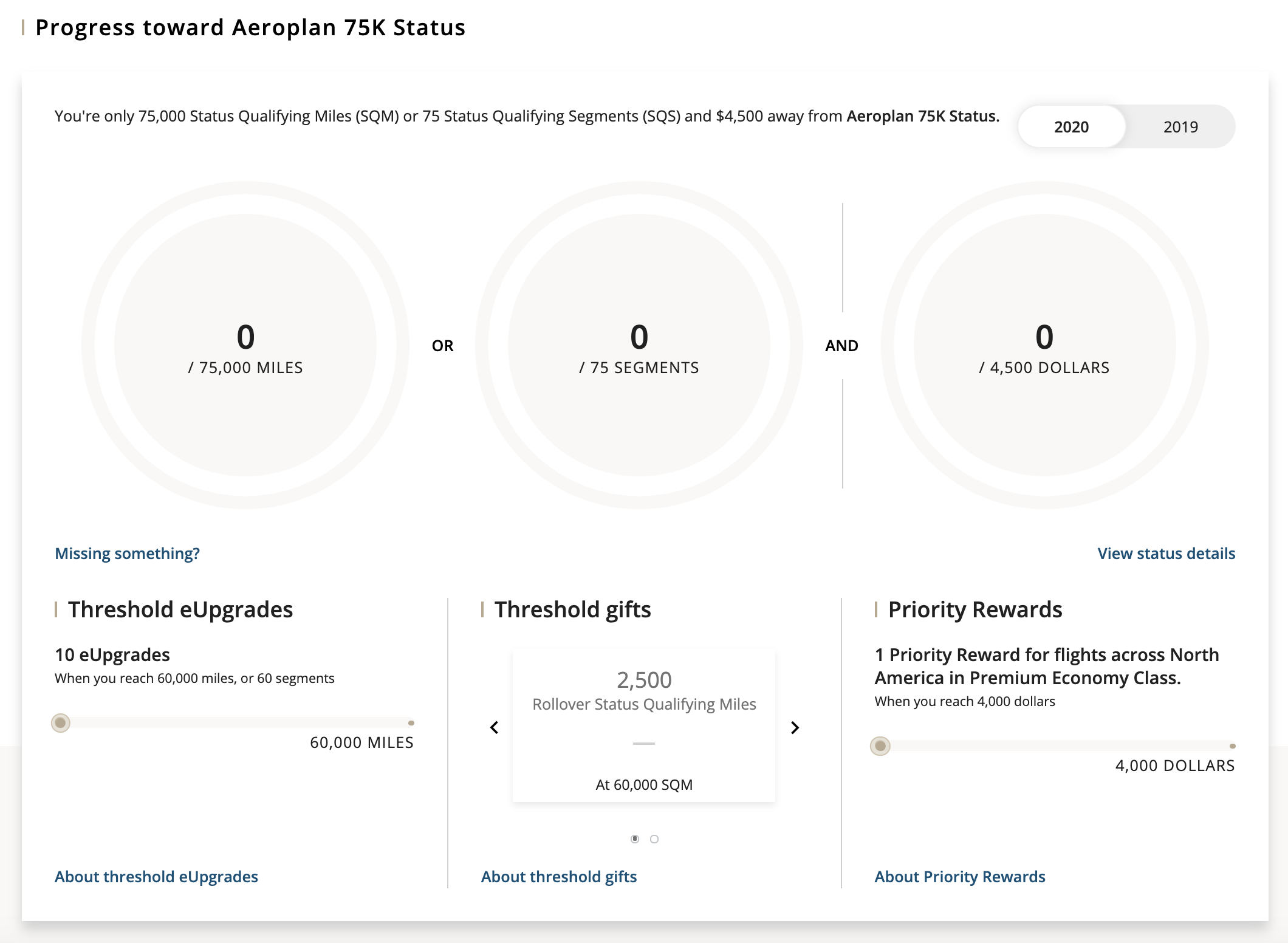
Of course, by far the most interesting feature is going to be when you head to the Air Canada homepage and see…

The New Search Engine
By selecting “Points” as part of the search toggle on the Air Canada homepage, you’ll be able to search for Aeroplan bookings the exact same way you’d search for a regular revenue flight. Everything is seamlessly integrated!
Before we delve into the flight pricing and the sweet spots, I’d like to highlight a few of the key improvements to the new Aeroplan search engine compared to the old one.
When inputting cities to search, IATA city codes (such as “NYC” for New York or “TYO” for Tokyo) are now supported, which is a welcome change from before.
 However, the search must still be completed one date at a time – I assume that the calendar search feature is yet to be implemented, even though it was announced as part of the plan.
However, the search must still be completed one date at a time – I assume that the calendar search feature is yet to be implemented, even though it was announced as part of the plan.
The new search engine shows all four classes of service side-by-side, although First Class doesn’t show up if none of the search results offer it. The search engine populates a far greater number of search results compared to before – the promise of “up to 150 search results” seems to have held true.
By default, the search results are sorted by a hybrid “Recommended” criterion: a combination of price, flight times, convenience, and airline (with Air Canada flights favoured towards the top of the search results). You can sort the results by the price for each class of service simply by clicking the triangles in the header for your desired class of service.
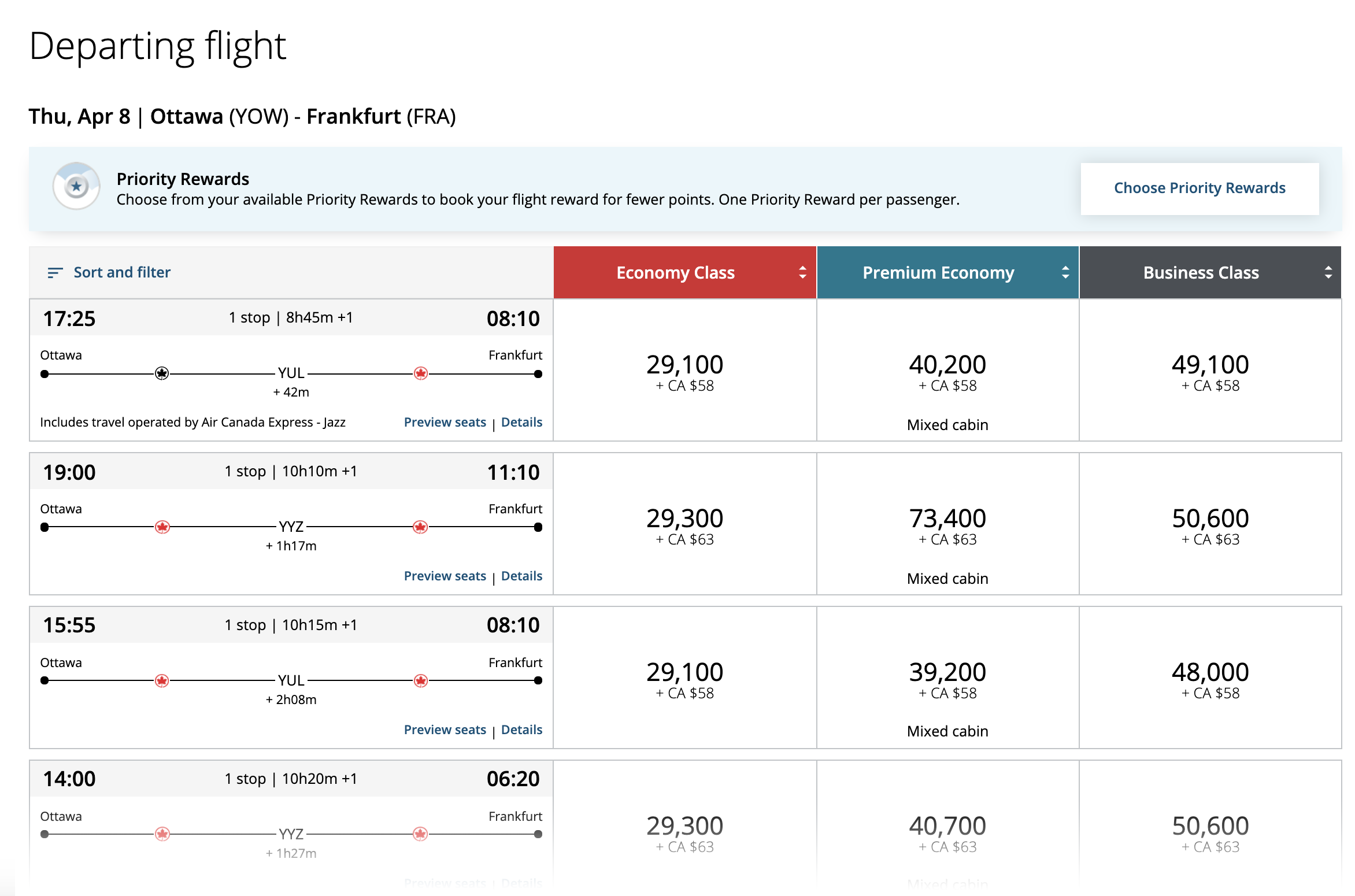
Then, by clicking “Sort and Filter” in the top-left corner, you can unlock a wider range of sort and filter criteria, such as the number of connections, the connecting airports, and the airlines involved in your itinerary. You can also toggle to display the aircraft type, flight number, information about eUpgrades, and the “bar display” for mixed-cabin itineraries.
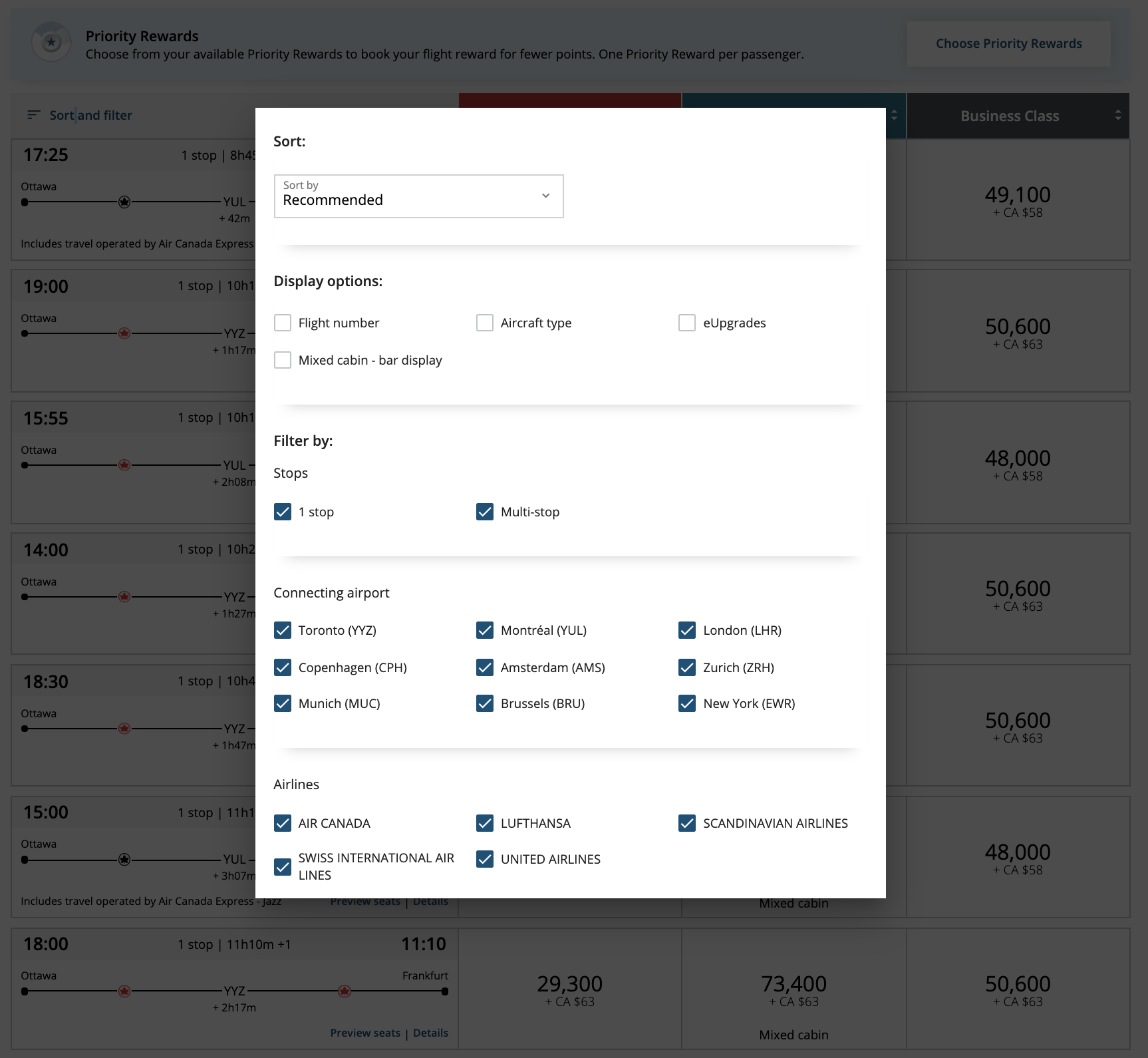
Those two final items bear some clarification. By toggling to display information about eUpgrades, you’ll get to see whether or not there’s available space in the class of service you wanted to upgrade to on any particular Air Canada flight, as well as how many eUpgrades (and how much co-pay amount, if any) would be required to upgrade for any given fare category.
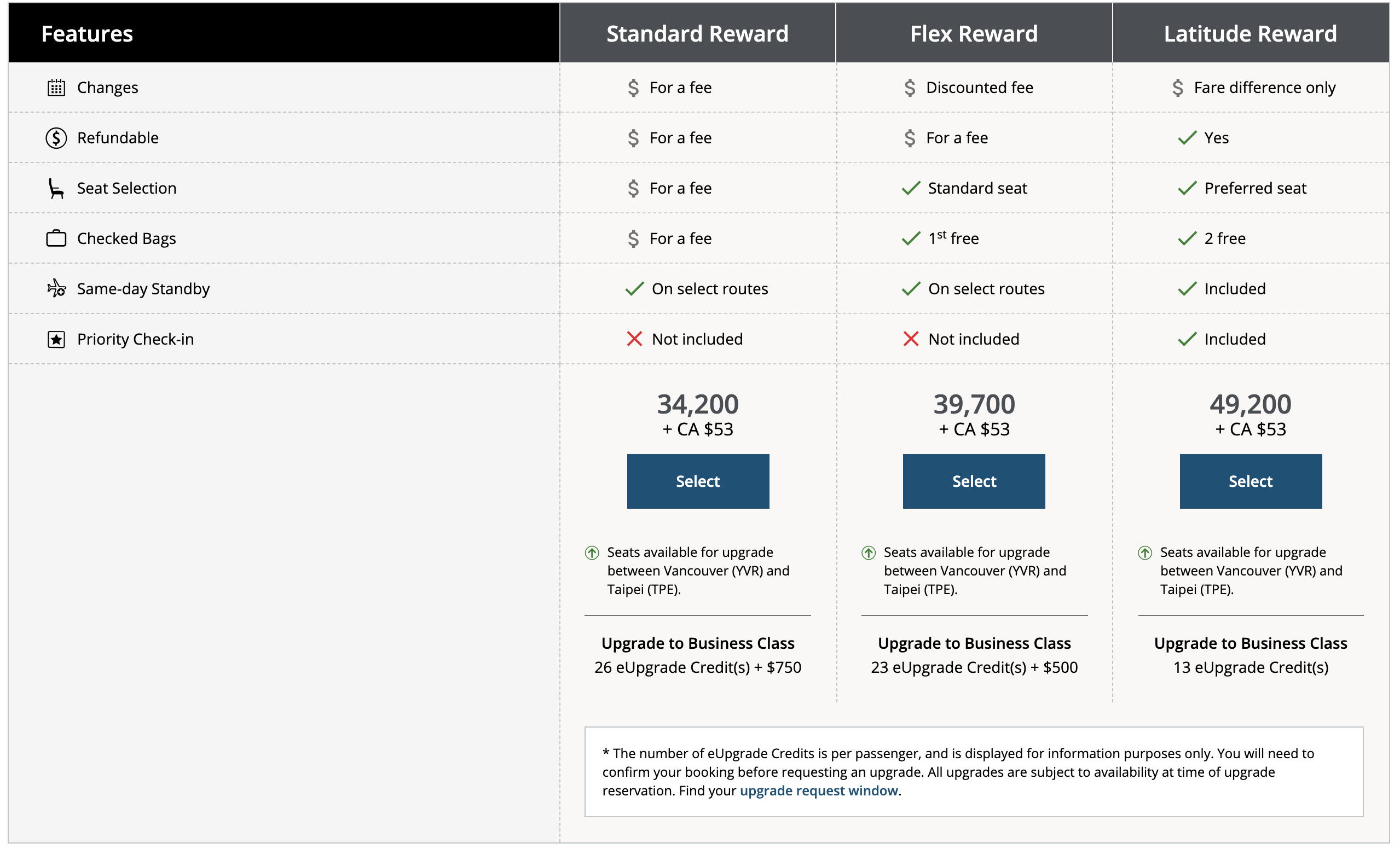
This is particularly handy when booking Economy Latitude rewards, which can be confirmed as an eUpgrade into business class instantly without having to wait for your eUpgrade request to clear a certain number of days before departure.
Then, let’s talk about mixed-cabin itineraries. One of the greatest frustrations with the old Aeroplan was the fact that the search engine would often populate mixed-cabin itineraries with a short flight in business class and the long segment in economy class. Now, the “true” composition of mixed-cabin itineraries is displayed much more transparently.
By default, if you hover over a mixed-cabin search result, you’ll see the percentage of the itinerary that’s in the true desired class of service.

By toggling “bar display” for mixed-cabin itineraries, you can also see a helpful bar icon to gauge how much of the itinerary is truly in the desired class of service.
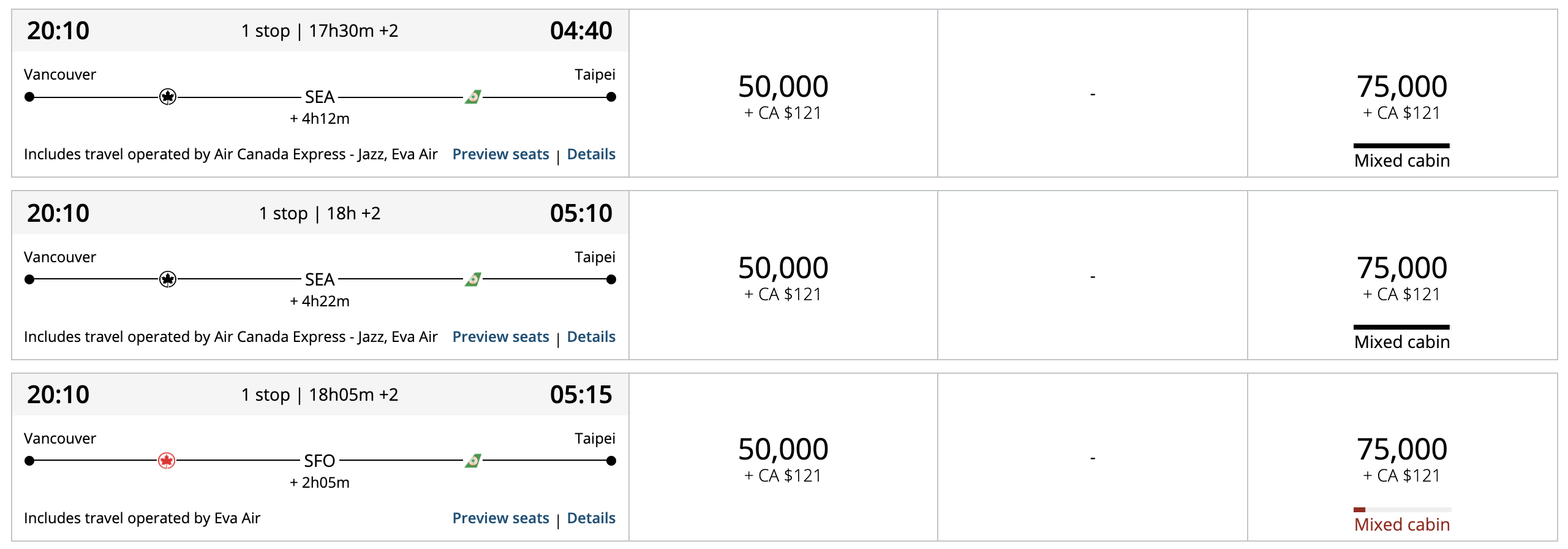
Finally, the one-way and round-trip search engines are straightforward, but there’s something very important to know about the multi-city search engine: it’s not quite complete just yet, and should mostly be avoided for the time being. We’ll discuss this further below in the section on complex trips.
Air Canada Dynamic Pricing
Now let’s talk about flight pricing. Remember, the Aeroplan Flight Reward Chart was released three months ago, so we’ve already known which partner-operated flights (subject to a fixed award chart) would be the best sweet spots in the new program.
One of the best examples is Vancouver–Tokyo on ANA business class, which is bookable for 55,000 Aeroplan points one-way, compared to 75,000 miles before:

All partner flights are priced as we expected based on the Flight Reward Chart, so there’s no real surprises there. Moreover, fuel surcharges have been eliminated across the board, so it’s great to be able to finally say goodbye to the “avoiding fuel surcharges” chapter in the history of the Canadian loyalty strategy.
Instead, the main unknown quantity coming into today was the pricing of Air Canada flights and how the dynamic pricing model would work.
In that regard, I personally find that the pricing varies much more wildly than I was expecting given Air Canada’s initial statements that the published ranges in the Flight Reward Chart reflects the prices of “around 90% of bookable seats”.
There are plenty of instances where the pricing on Air Canada flights shows up below the published range, such as Air Canada business class flights to Europe and Asia on many dates in the spring and summer (many of which are even cheaper than they were under the old Aeroplan program)…



…as well as many instances where the pricing shows up far above the published range, such as long-haul flights on the Vancouver–Sydney route year-round, Toronto–Tokyo flights during next year’s Olympics, or even short-haul flights on the Montreal–Ottawa route on most sample dates.


 We knew that the new dynamic pricing model would reflect the underlying cash fare and would result in many winners and losers depending on your preferred routes and destinations, but I must say I wasn’t expecting quite this level of variability in the prices.
We knew that the new dynamic pricing model would reflect the underlying cash fare and would result in many winners and losers depending on your preferred routes and destinations, but I must say I wasn’t expecting quite this level of variability in the prices.
It certainly feels like a lot more than 10% of the flights are falling outside the published range, thus resulting in less predictability to the prices of Air Canada flights, which is a net negative in my books.
On the other hand, there turns out to be far more sweet spots on Air Canada business class flights than I was expecting (with no fuel surcharges, to boot!)
Take a look at the following chart that Prince of Travel reader Hari put together (having conducted his search as an Aeroplan 25K member), demonstrating that a great majority of Air Canada business class flights are clocking in well below the minimum of the published ranges.
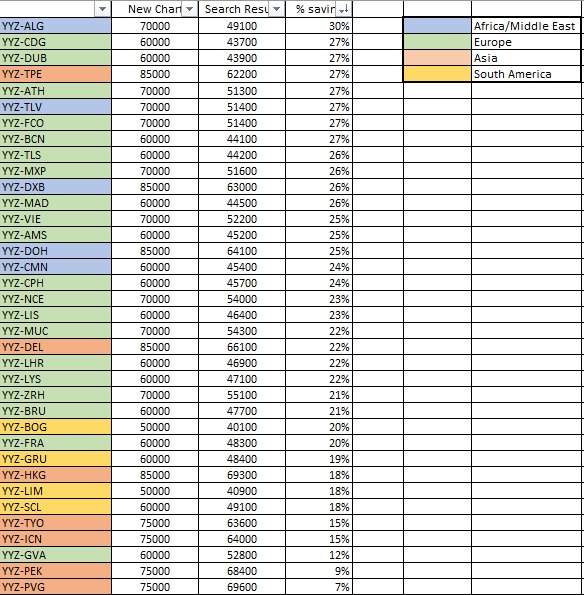
However, keep in mind that there’s a chance that these cheaper-than-the-chart awards are merely the result of lowered demand across the board due to the current pandemic, and may well increase in the future. Time will tell how this plays out, but it’s good to record these examples as of the time of launch, so that we can keep close track if changes were to occur.
One thing to note about the Air Canada dynamic pricing is that it seems to apply to each class of service independently on any given flight. That means that we often see situations where the premium economy pricing is higher than business class, which doesn’t make much sense on the surface, but supposedly reflects underlying demand for premium economy being relatively stronger than business class.

It’s tricky to establish what are “the best sweet spots” under Air Canada’s dynamic pricing model, since they can always change at moment’s notice. I’ll leave it to you to play around with different city pairs and find what works for you.
However, I think we can conclude a few things, as things currently stand:
- The anticipated devaluation to the Atlantic award chart may not be as bad as originally feared, as long as you’re somewhat flexible within a few days.
- Many of us may now be incentivized to fly Air Canada business class internationally rather than partners – a reversal from the circumstances under the previous Aeroplan program.
Preferred Pricing
All of the above search results show up for an Aeroplan user who isn’t logged in. If you’re an Aeroplan member with Aeroplan Elite Status or a co-branded credit cards, then you’ll actually see reduced prices on Air Canada flights under the Preferred Pricing benefit.
For example, in the examples above we saw Toronto–London business class seats available for 50,200 Aeroplan points. When I log in as an Aeroplan 50K member with a core credit card, I see the following instead:

The Prince of Travel team has spent many hours conducting some sample searches to help us determine the “impact” of preferred pricing based on both criteria: Elite Status and credit cards. Look out for the full charts in an upcoming post.
For now, some of the patterns I’ve observed include:
- Having status vs. not having status seems to matter more than the specific level of status you have. The difference from no status to Aeroplan 25K is more significant than the difference from Aeroplan 25K to Aeroplan 50K or even Aeroplan Super Elite.
- Similarly, having a credit card vs. not having a credit card seems to matter more than the specific level of credit card you have (e.g. premium vs. core).
From the above, we can conclude that even members who show only a minimal degree of meaningful participation in the program will be rewarded in the form of lower pricing on Air Canada flights.
It’ll be important to hold onto at least one Aeroplan co-branded credit card, or perhaps earn Aeroplan 25K status even if you don’t fly with Air Canada too often via Everyday Status Qualification (i.e., the ability to earn Aeroplan 25K by earning 100,000 Aeroplan points per year through eligible sources).
Look out for an upcoming post with more detailed data collection and analysis to help us tease out the patterns when it comes to both Air Canada’s dynamic pricing as well as the preferred pricing that’s layered on top.
Different Fare Categories
One of the unknowns coming into today was how the new Aeroplan’s different fare categories would be priced.
We’ve known that economy class bookings could be made in Standard, Flex, or Latitude (Standard or Latitude only for partner bookings); in addition, premium economy, business class, and First Class could be booked in either Lowest or Flexible – but we didn’t know what the pricing would look like.
Looking across the board, the following ranges seem to hold true for the fare category differentials:
- Economy Flex: ~5,000 Aeroplan points above Economy Standard
- Economy Latitude: ~14,000 Aeroplan points above Economy Standard
- Premium Economy Flexible: ~8,000 Aeroplan points above Premium Economy Lowest
- Business Flexible: ~10,000 Aeroplan points above Business Lowest
- First Flexible: ~14,000 Aeroplan points above First Lowest
You’ll note that these differentials are estimates. Sometimes the Economy Latitude might be, say, 13,500, 14,500, or 15,000 points above Economy Standard, for example. But by and large, these estimates seem to hold true across all of the searches we’ve done so far.
What’s the benefit of booking in a higher fare category? On Air Canada flights, you’ll get certain perks such as additional checked bags and free seat selection. Moreover, your ticket will be subject to lower or waived change and cancellation fees if you choose to book a higher fare category:
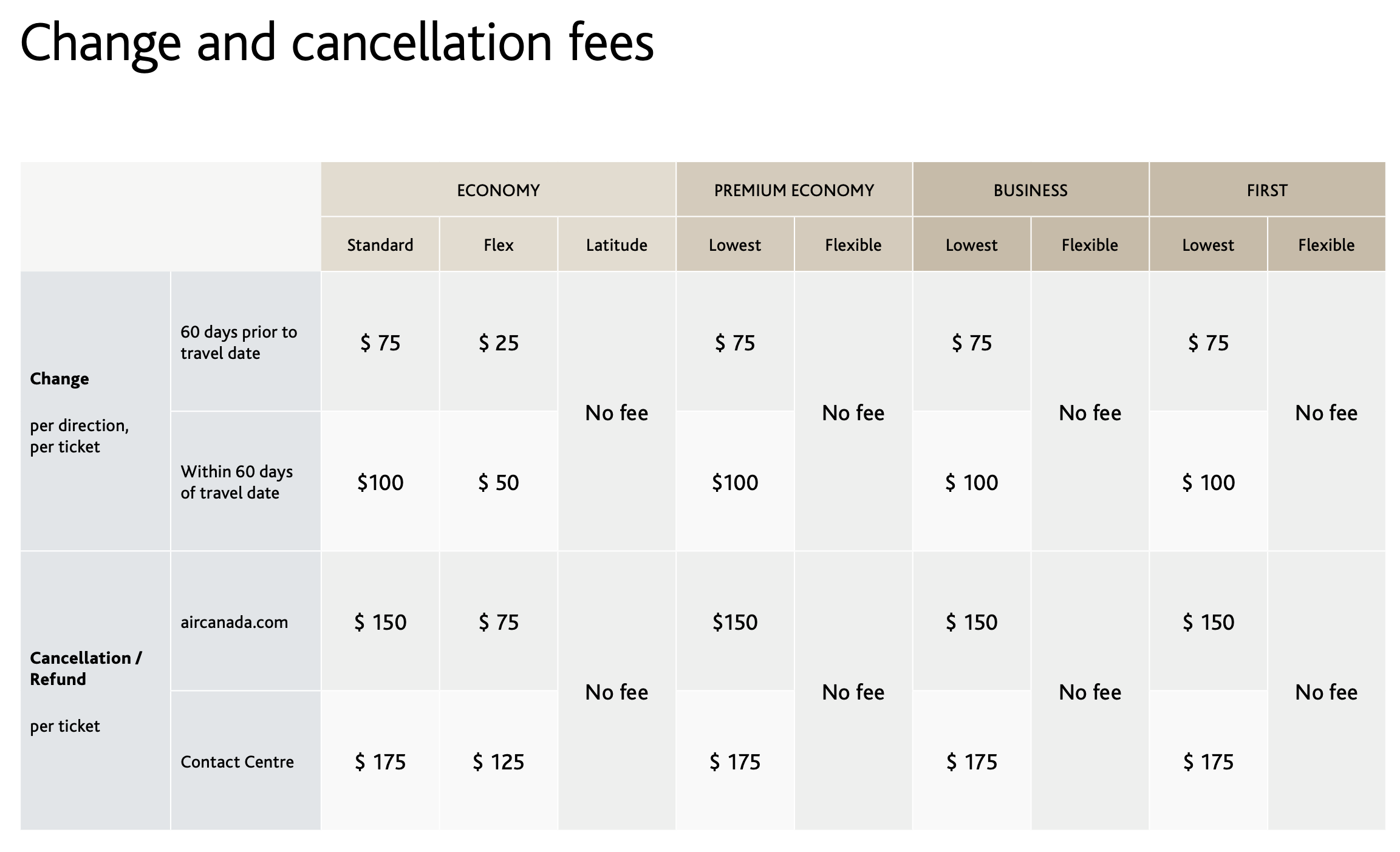
Moreover, Air Canada business class tickets booked using Aeroplan points in the Business Flexible fare family will be granted access to the Air Canada Signature Suites in Toronto and Vancouver. These lounges are considered some of the best in North America, offering à la carte dining, specialty cocktails, and shower rooms, and previously they were only accessible to paid Air Canada business class tickets.
Signature Suite access on Business Flexible tickets is therefore a big improvement for aspirational travellers, and I look forward to visiting the Signature Suite for the first time myself on one of these redemptions in the future.
Keep in mind that the above estimates are based on the search results we’re seeing right now as of the launch. They may change in the future, and I’ll be sure to let you know if they do.
Points + Cash
Another unknown coming into today was how the Points + Cash feature would work. What implied valuation of Aeroplan points would Points + Cash draw upon to calculate the number of points and cash required?
Upon clicking “Select” on any award on the search results, you get taken to the booking confirmation page (if you are not logged in, you’ll be instructed to log in first, after which your preferred pricing discount will be reflected).
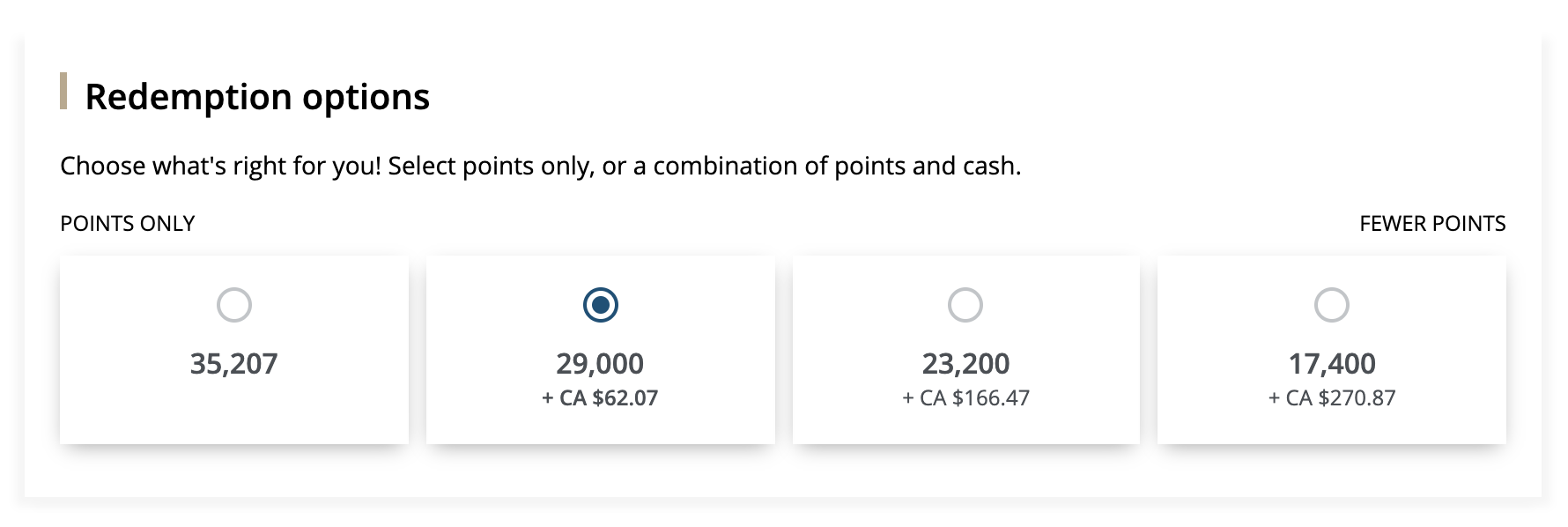
The booking confirmation gives you four separate “redemption options” under Points + Cash. If we run the numbers here, we see that we’re essentially being offered the chance to either sell Aeroplan points at 1 cent per point (cpp) or buy Aeroplan points at 1.8cpp.
If you select the “Points Only” option, all of your taxes and fees get converted into a points amount at 1cpp, and those points are added to your total. Meanwhile, if you move in the direction of “Fewer Points”, you get to pay either 80% or 60% of the total points cost, and the remaining points get converted into a cash amount at 1.8cpp and added to your cash co-pay amount.
It’s almost never a good idea to effectively sell Aeroplan points at 1cpp, since you can almost always redeem them for greater value in the future. However, on the buy-side, 1.8cpp could be an attractive value at which to effectively buy – indeed, that’s the optimal value at which you can currently acquire Aeroplan points by buying Air Canada tickets and converting them into Aeroplan points.
If you were confident of getting higher than 1.8cpp in value for your Aeroplan points in the future, then some of the “Fewer Points” payment options might make sense, since they’d allow you to save your points for higher-value redemptions later on.
Similar to the fare category differentials above, the Points + Cash implied valuations may also change in the future depending on whether Air Canada would like to encourage people to earn or spend their Aeroplan points. I’ll be sure to let you know if I see any changes to these valuations, as they most likely won’t be announced publicly otherwise.
Priority Rewards
If you’re an Aeroplan 35K member or above (or if you’ve racked up lots of SQD this year), then your Aeroplan account will already be equipped with a handful of Priority Rewards. These will show up at the top of the search engine whenever you’re looking for a flight.

If your Priority Reward is eligible for the route you’re currently searching for, then you can choose to apply it to the search results. The eligible flights will then have their prices instantly reduced by 50%.
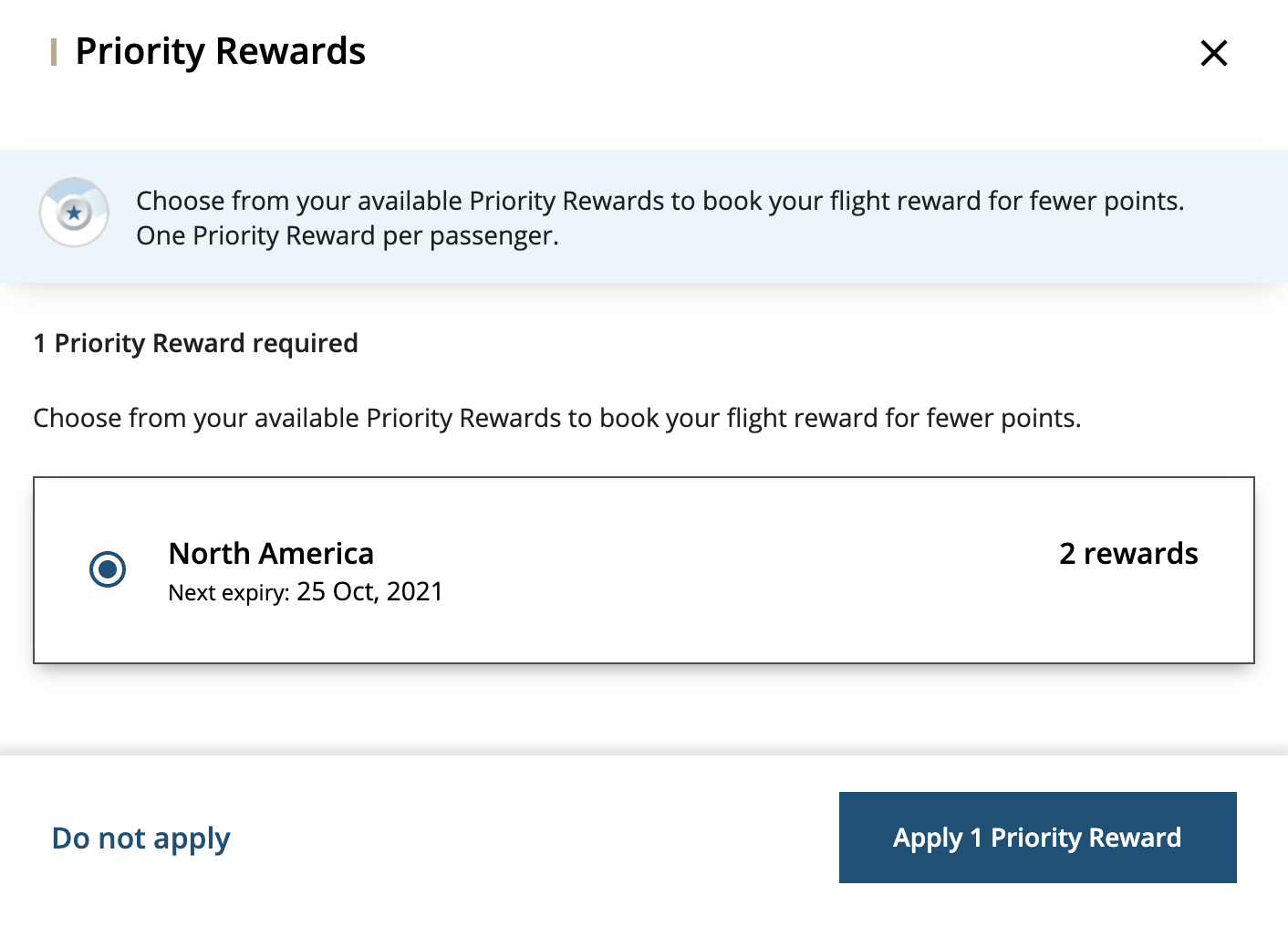
For example, as an Aeroplan 50K member, my two Priority Rewards can be used to secure a 50% discount on any redemption within North America in any class of service up to premium economy.
Upon applying my Priority Reward on a search for Ottawa–Curaçao, then, the economy class awards get halved, but the business class awards do not.
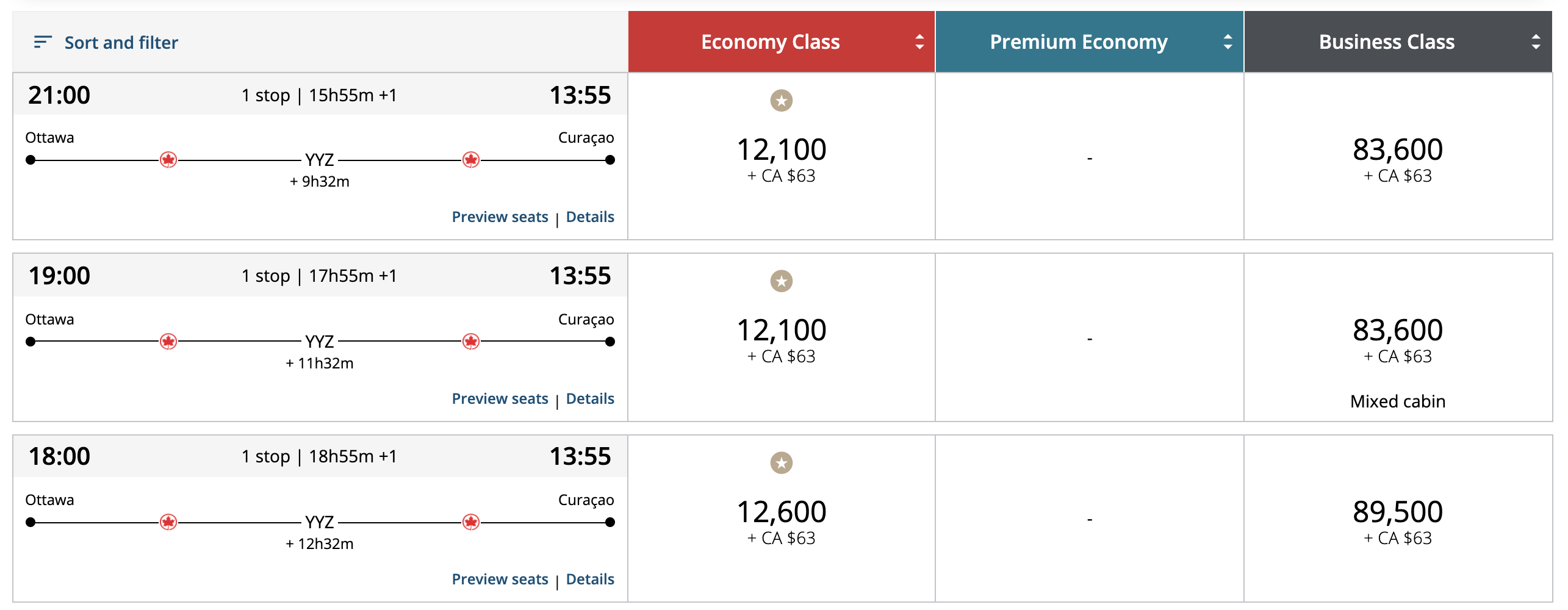
So, the question is: have you buttered up any of the Aeroplan Super Elite friends in your circles yet?
Complex Bookings
Now we arrive at one of the most disappointing parts of today’s Aeroplan launch: the multi-city search engine isn’t nearly as useful as we would’ve hoped for.

The new Aeroplan program applies one-way bound logic to any proposed itinerary, dividing the itinerary up into separate bounds and then pricing each bound according to the Flight Reward Chart. If you need to brush up on one-way bound logic, you can refer to my post on “New Aeroplan Mini-RTW: A New Generation of Complex Trips”.
The multi-city search engine can support two fields of airports – but unfortunately, no matter which airports you input, it will always price things out as two separate one-way bounds (and essentially bill you for two separate awards). It’s not yet smart enough to apply the proper bound logic to the full itinerary.
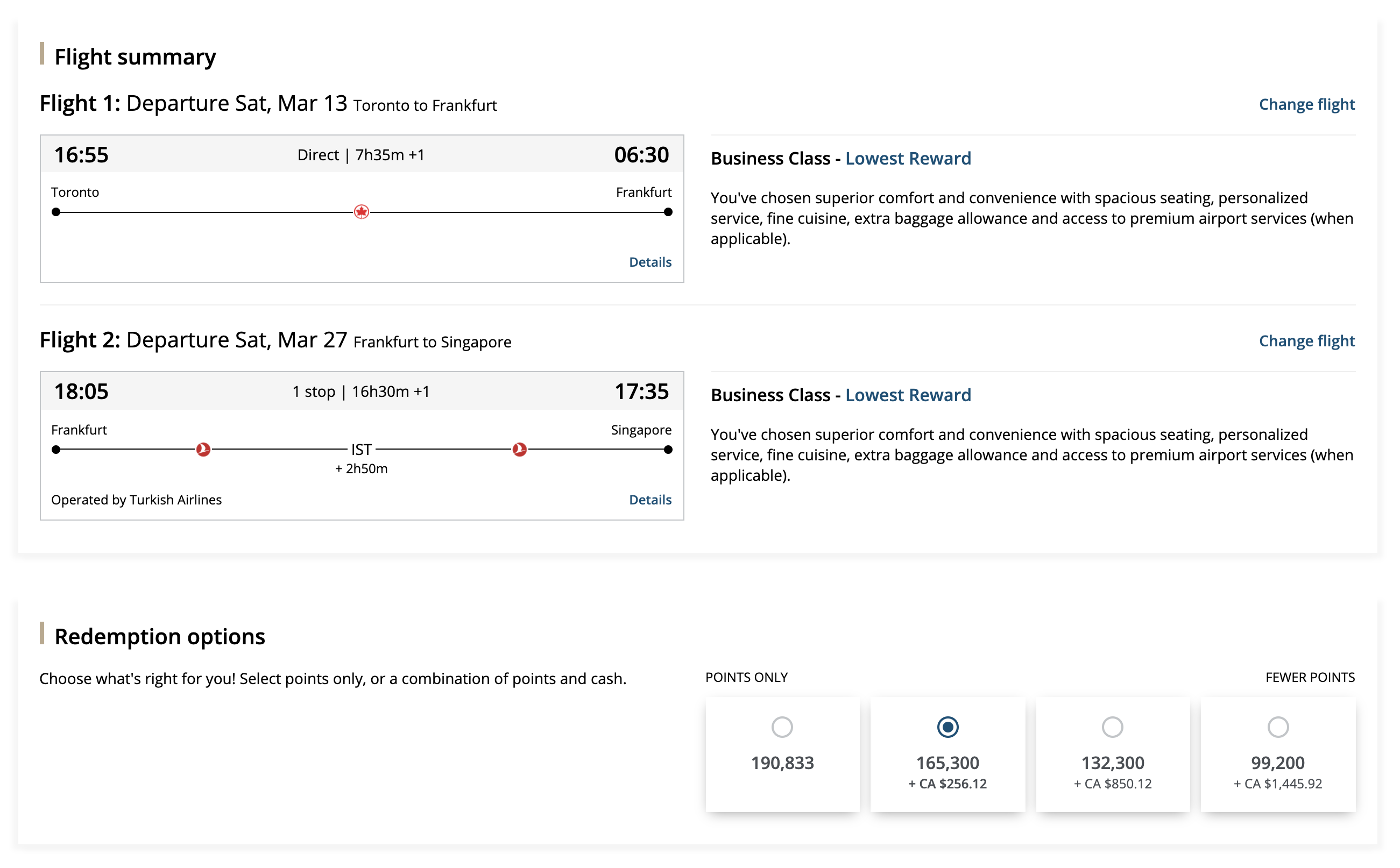
This also means that the much-anticipated ability to add a stopover on a one-way award for 5,000 Aeroplan points is not bookable online at this moment.
If you want to add a stopover to a one-way journey (or indeed, any journey) for 5,000 Aeroplan points, then you’ll need to call the contact centre to book it. If you try to book it using the multi-city tool, you’ll end up being charged as two separate awards, which is far more expensive than what you actually need to pay.
To be fair, we were told that the full multi-city search engine, which would support custom routings of up to six one-way bounds and 16 segments, would be coming later in 2021. However, I’m still disappointed that the current multi-city search engine isn’t smart enough to determine when two journeys should be combined on the same one-way bound with a stopover in between.
Consequently, the only real purpose that the current multi-city search engine serves is if you wanted to book an open-jaw, like Vancouver–Taipei; Tokyo–Vancouver. In this case, the multi-city tool would output the correct price, while allowing you to combine both directions on the same award and pay only one set of the $39 partner fee.
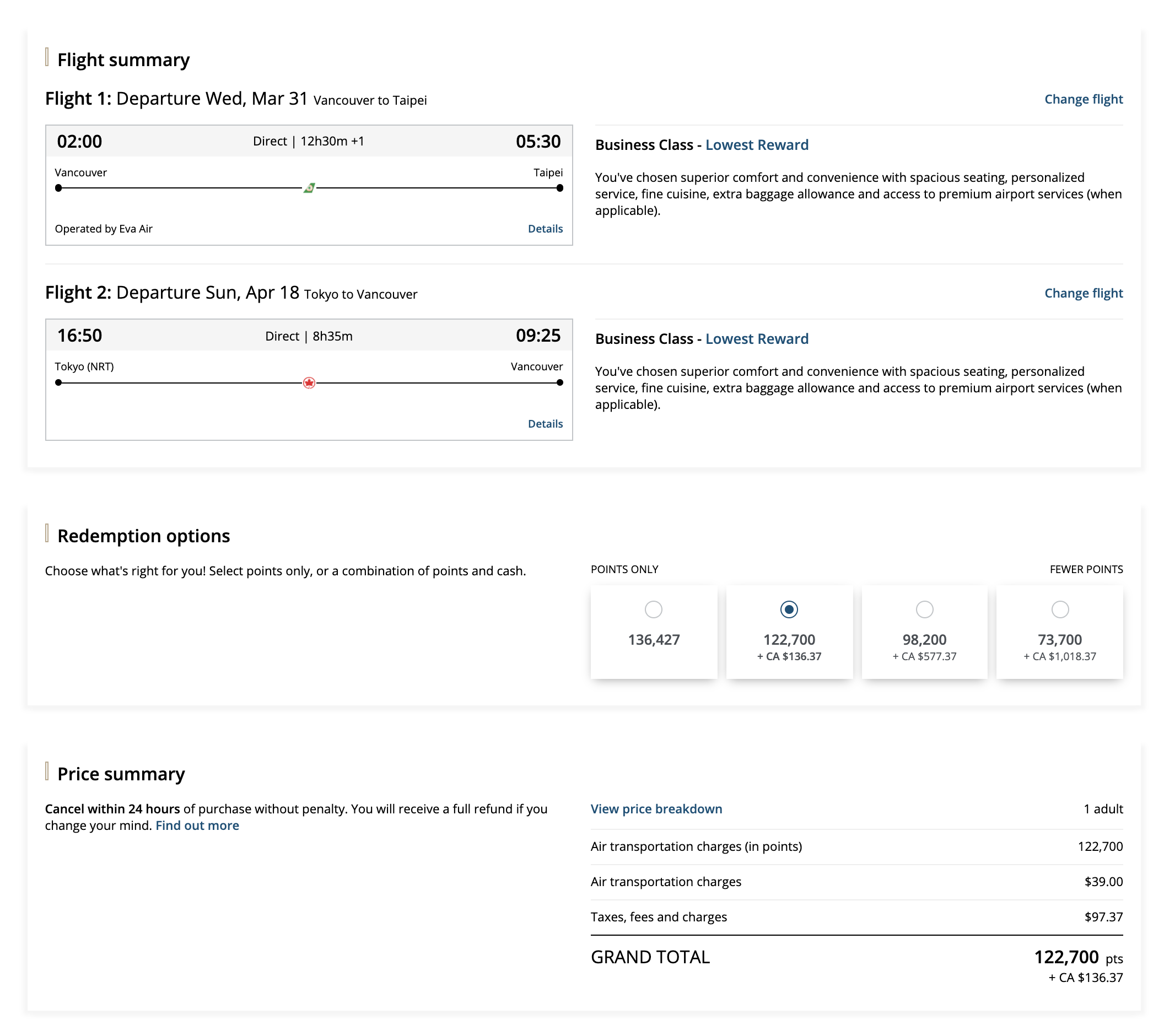
Aeroplan Call Centre
So, complex bookings and stopovers on a one-way will need to be booked over the phone for the time being. Which raises the question: how’s the Aeroplan call centre doing these days?
If you watched our live Aeroplan walkthrough stream earlier today, then you’ll know that unless you’re an Aeroplan Super Elite member, you can expect relatively long wait times when calling Aeroplan at the moment. Moreover, agents may still be familiarizing themselves with the new system, so you’ll need to have plenty of patience if you choose to call in.
During my test calls this afternoon, I noticed a new procedure for pricing out awards. Since everything is now fare-based and the pricing of Air Canada flights may depend on your status level and credit card ownership, the agents actually need to take down your name and Aeroplan number before being able to price out an award. The process of testing out different routings and seeing how they price may therefore take more time than before.
Keep in mind that the Air Canada dynamic pricing model may throw up just as many surprises over the phone as it does online. For example, I priced out an itinerary of Ottawa–Frankfurt (stopover)–Istanbul in June 2021 for only 56,700 Aeroplan points – and that’s with the 5,000 Aeroplan points for a stopover included!
Meanwhile, another test for Vancouver–Taipei (stopover)–Bangkok on EVA Air and Thai Airways business class resulted in the expected amount of 90,000 Aeroplan points: 85,000 Aeroplan points for the routing based on the Flight Reward Chart, plus 5,000 Aeroplan points for the stopover.
It seems that any itinerary that’s even a little bit complex will need to be called in, at least over the next few months before the full custom-routing search tool launches online. If you run into any interesting experiences with the contact centre, be sure to let us know in the comments below!
Conclusion
Air Canada’s new Aeroplan program is finally here, and as we already knew beforehand, there’s a mix of good and bad developments as a result of the many new elements to the game: a new award chart, a new search engine, dynamic pricing on Air Canada flights, preferred pricing, fare families, and Points + Cash.
On the other hand, some of the struggles with the old Aeroplan, like the challenges of booking complex trips online, remain in place for now until Air Canada can address them in the future.
Over the upcoming weeks and months, I’ll be slowly updating our previous Aeroplan-related content based on the new ecosystem that we’re now playing in. Stay tuned!
In the meantime, I’m sure you’ll all be spending lots of time playing around with Aeroplan and perhaps even making some bookings at the surprise new sweet spots – even if they may be temporary – that we’ve seen today. Let me know in the comments if you find anything exciting!
Finally, in case you missed it, you can replay the below livestream from the afternoon of November 9 to follow along as I hop on to the platform and play around with all of the new features for the first time.

















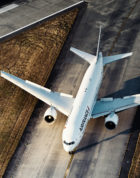


Good article, I’ve now read it twice without even realizing it cuz there’s so much content in this 1 giant post broken up multiple times.
One thing I’m noticing doing some dummy searches is unfortunately the user is punished for their connections, even if they are involuntary.
I’ll combine the old and new with the following example. Under the new rules Canada-South America is cutoff at < 4,500 miles or 4,501 and up. YVR-MDE is 4,059 so it's pushing that cutoff and of course there's no direct flights. Under the OLD program, you could connect in any number of cities for the same price (other than added taxes/airport fees), so some people like me took advantage of that of course. But even the system would offer something like YVR-YYZ-BOG-MDE. That's a VERY reasonable routing so the system would often spit that one out. But under the new setup that's 4,922 so it adds (in theory) minimum 10,000 AP more to the cost. My problem is the user is punished even if they aren't TRYING to choose this routing. If it's the only one available, then you get punished. There's going to be plenty of times where there's no AV/CM/UA space and the only option is Air Canada. In the new program, they've made it palatable to fly AC which is nice, but let's assume also that it's…spring break or whatever, well now that AC dynamic pricing will also kick in. So not only are you being beaten up by the dynamic price (but to be fair at least the seats are open) but you're ALSO getting hit with extra points to pay because you've exceeded the mileage threshold.
YVR-SFO-PTY-MDE or YVR-LAX-PTY-MDE are likely the most direct routes but connecting in IAH/DEN/BOG also works. But then a pretty direct route like YVR-MEX-BOG-MDE doesn't work because it's 4,545.
So again, depending on where you live and what hubs offer connections to where you're going, there's gonna be instances where you're totally incapable of actually achieving the lowest price point even though in theory it's available and in practice the flights are available, but the routing doesn't allow for it.
I guess we had this issue previously with MPM, but MPM was really only affecting people like me who were trying to connect in every city in Asia before getting to BKK to try flying every airline I could. Now, everyone is gonna get hit with this depending on the situation.
We've mentioned the sweet spot of western canada to Tokyo, for Vancouverites it works but only on direct flights or connecting via Seattle. If you live in Calgary you're screwed. It works if AC has seats open on the direct flight, but with no competition by ANA, they're automatically forced into the 5,001-7,500 price category, which just kinda isn't fair IF you're not actually trying to game the system.
I'm rambling a bit trying to get the point across, but it would've been nice to see them build in the ability for the system to offer routings where the CITY PAIR fits in the zone band regardless of what cities are offered as connections. If a person in Calgary isn't trying to have a stopover in a reasonable city like SFO, they should still be able to connect there imo.
I mean, no surprise that some of these are well priced partly because of lowered demand, but also because the chart is all from YYZ. From YVR where I’m located Europe is always gonna be a bit tougher. That said, being able to use LH now is a huge plus, it was totally infeasible before but there were always seats. I’m sure seat competition now will be a bit harder and I don’t really wanna fly their J product, but I love LH Y and will be happy to fly YVR-FRA if the mood strikes.
I think an underrated positive is the quality of the Air Canada product these days. Now that we’re all not trying to avoid AC, it’s nice to know that the product is also good. Had this been done like 6-8 years ago, you still wouldn’t have wanted to fly AC in many cases. Now of course, product life cycles are finite, so in 2-3 more years of heavy usage, this current AC J product might be terrible, but right now, I personally think it’s one of the best products in north america, and at least competitive worldwide. The soft product might need a little work, but no one is ever going to treat you as well as the asian and ME3 carriers do. I would rate UA Polaris on par/ahead of the AC product, but the UA 2-2-2 product on the 787s is kinda trash imo, paying all that money or miles and not having direct aisle access is kind of a deal breaker for me.
I still find the website a bit frustrating, I expect search improvements, but also the site is just too busy to be searching on that homepage IMO and the app to this point can’t do multi city that I’m aware of.
Thanks for the comprehensive breakdown of the new Aeroplan benefits. Has there been any talk around rolling over 2020 Altitude statuses considering air travel has all been shut down in 2020?
Are SQD (new AGD) calculated at a 1:1 ratio? Trying to calculate prospective SDQ for 2021 and I can’t seem to find that info. I was always under the impression that it wasn’t 1:1 and and it was far more complex calculation.
SQD is 1:1 based on your spending on AC-marketed flights (including base fare and carrier-imposed surcharges, but excluding taxes and fees).
*new AQD
So far I have been impressed with some of the price points (granted demand is as low as it will ever be currently). I cross referenced everything I have pre-booked before Nov 6 5pmEST and in most cases for myself there is a marginal increase (5k-10k pts), thus if things continue to remain bleak throughout 2021, it won’t be as devastating as I feared to rebook into 2022.
Overall disappointed in the pricing at the moment, and this is WITH the demand super low on the whole. Some sweet spots sure, but the 20% dip- if you’re lucky – on some prices for example, compared to the horrific escalation of prices on other flights is severely lopsided. I mean, holy cow, flights to Australia/New Zealand are almost comedically PAINFUL…in some cases 620,000 ONE WAY?
The site is just horrifically buggy. I can select flights no problem, but actual confirmation page never works – throws an error message or says insufficient points. Worst so far though is it just increases the number of points required.
I created a family plan and added my husband, and have a similar error you are saying…I can’t complete a booking, it thows an error message and says call aeroplan. It also increased the number of points required by a lot. On my daughter’s account, which I did not add to hte family plan yet, I was able to book and confirm a ticket. So for sure, family plan appears to be a problem – probably because the IT systems are not allocating the points needed to the accounts in the plan or some other problem. I tried calling aeroplan – after two hour wait, the call just hung up.
That must be it. I had just enabled the family plan as well.
I am on call with aeroplan – confirmed wth an agent there is an issue online with redeeming multiple tickets when you have a family plan. The agent was able to manually book multiple tickets for me, and I confirmed that I was able to book an individual ticket using the family plan (then had the agent link the individual reservations). Hopefully it will get fixed properly, but this is a workaround.
The points for redemption look good right now because so many flights are empty… Wait till its summertime or its safe to travel again/vaccine roll out and points to redeem will be skyrocketing.
Better start booking for next year now!
Hi Ricky, will the cancellation fee waiver for Aeroplan bookings until Dec 31 still be in place for new bookings? Couldn’t find the details on the website…
Yes – as will the unpublished “one free change” rule.
New engine still not that smart about connections. YUL-JNB on Oct 1st available in Business all the way (IST-CAI-JNB full business, with the optimum 3h connection in Cairo) and instead routes you routes you through EWR and from there on United (which makes sense), except it’s not in business class for the long portion of the trip! I can’t believe we’ll still need to call in and feed them the segment by segment
First class bookings don’t seem to work either. It shows 60% in first class mixed cabin but when you click through its economy and business.